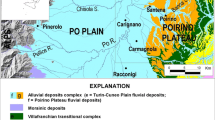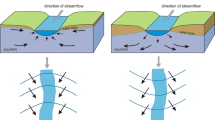Abstract
This paper discusses the effects of the dilution process on levels of aquifer contamination attenuation, developing analytical equations for application in theoretical and practical cases. The key finding is that, in aquifers, the dilution process causes a reduction of the contaminant concentration. Analytical equations for the assessment of the contaminant attenuation capacity, by means of the dilution process in an aquifer, are put forward. In particular, the attenuation of the contaminant concentration in an aquifer, and thus the dilution, is described by the volumetric flow rate per unit width perpendicular to the flow direction (q u). Moreover, a classification of q u was developed, considering six classes of attenuation capacity due to dilution. For the equations validation, nitrate contamination attenuation due to dilution was analysed in two sample areas in Piedmont (North-West Italy). The results confirmed the hypothesis, evidencing high nitrate concentrations in areas with low q u values, connected to low dilution rate of the contaminant in the groundwater; vice versa, low nitrate concentrations were evidenced in areas with high q u values, due to a high nitrate dilution rate.














Similar content being viewed by others
Abbreviations
- b :
-
Aquifer thickness (m)
- C ae :
-
Contaminant concentration in the cell input (mg/l)
- C i :
-
Contaminant concentration in the infiltration water (mg/l)
- C u :
-
Expected contaminant concentration in the cell output (mg/l)
- C w :
-
Actual nitrate concentration in the groundwater (mg/l)
- i :
-
Hydraulic gradient (dimensionless)
- I e :
-
Infiltration rate (m/year)
- k :
-
Hydraulic conductivity (m/year)
- L :
-
Cell length (m)
- P :
-
Cell width (m)
- Q :
-
Volumetric flow rate (m3/s)
- Q ae :
-
Groundwater flow rate used for cell input (m3/year)
- Q i :
-
Infiltration flow rate (m3/year)
- Q u :
-
Groundwater flow rate in cell output (m3/year)
- q u :
-
Volumetric flow rate per unit width, perpendicular to the flow direction (m2/s)
- S :
-
Area of the cell (m2)
- T :
-
Transmissivity (m2/s)
References
Aller L, Bennet T, Lehr JH, Petty RJ, Hacket G (1987) DRASTIC: a standardized system for evaluating ground water pollution potential using hydrogeologic settings. NWWA/EPA Ser. EPA 600/287035
American Petroleum Institute (1996) Estimation of Infiltration and Recharge for Environmental Site Assesment. Daniel B. Stephens & Associates, Inc., API Publication 4643
Atxotegi U, Iqbal MZ, Czarnetzki AC (2003) A preliminary assessment of nitrate degradation in simulated soil environments. Environ Geol 45:161–170
Bekesi G, McConchie J (2002) The use of aquifer-media characteristics to model vulnerability to contamination, Manawatu region, New Zealand. Hydrogeol J 10:322–331
Biancotti A, Bellardone G, Bovo S, Cagnazzi B, Giacomelli L, Marchisio C (1998). Distribuzione regionale di piogge e temperature. Collana Studi Climat. Piemonte 1:80, 21 tabb., 30 ff. (CD-Rom)
Burt TP, Matchett LS, Goulding KWT, Webster CP, Haycock NE (1999) Denitrification in riparian buffer zones: the role of floodplain hydrology. Hydrol Process 13:1451–1463
Buss SR, Rivett MO, Morgan P, Bemment CD (2005) Attenuation of nitrate in the subsurface environments. Environment Agency Science Group report SC030155/2
Carraro F (ed.) (1996) Revisione del Villafranchiano nell’area-tipo di Villafranca d’Asti. Il Quaternario 9(1), p 119
Clay DE, Zheng Z, Liu Z, Clay SA, Trooien TP (2004) Bromide and nitrate movement through undisturbed soil columns. J Environ Qual 33:338–342
De Luca DA, Lasagna M (2004) Use of the dilution attenuation factor in the groundwater contamination evaluation, with particular reference to nitrate pollution. 32nd Int. Geol. Congr., Florence, Italy, 20–28 August 2004, Abs. vol., pt. 1, abs. 140–26
De Luca DA, Lasagna M (2005) Aquifer role in reducing nitrate contamination by means of the dilution process. Proceedings of the 6th International Conference “Sharing a common vision of our water resources”, Menton, France, 7–10 September 2005, Paper EWRA066c
De Luca DA, Lasagna M, Morelli di Popolo e Ticineto A (2007) Installation of a vertical slurry wall around an Italian quarry lake: complications arising and simulation of the effects on groundwater flow. Environ Geol 53:177–189
De Vecchi Pellati, Pesce (1986) Censimento consorzi irrigui. Censimento degli organismi gestori di irrigazioni collettive in piemonte (pianura e collina). Esa
Debernardi L, De Luca DA, Lasagna M (2005) Natural denitrification in groundwater in the western sector of the Po Plain (northern Italy). Proceedings of Aquifer vulnerability and Risk, 2nd International Workshop and 4th National Congress on the Protection and Management of Groundwater—Reggia di Colorno (PR), Italy, 21–23 September 2005, Paper ID 176, p 27
Debernardi L, De Luca DA, Lasagna M (2008) Correlation between nitrate concentration in groundwater and parameter affecting aquifer intrinsic vulnerability. Environ Geol 55:539–558
Enwright N, Hudak PF (2009) Spatial distribution of nitrate and related factors in the High Plains Aquifer, Texas. Environ Geol 58:1541–1548
Evans TA, Maidment DR (1995) A spatial and statistical assessment of the vulnerability of Texas groundwater to nitrate contamination. CRWR Online Report 95-4. Web. 01 Aug. 2012. http://www.crwr.utexas.edu/gis/gishydro00/library/evans/rep95_4.htm
Farooq SH, Chandrasekharam D, Norra S, Berner Z, Eiche E, Thambidurai P, Stuben D (2011) Temporal variations in arsenic concentration in the groundwater of Murshidabad District, West Bengal, India. Environ Earth Sci 62:223–232
Firestone MK (1982) Biological denitrification: in Nitrogen in Agricultural Soils. Stevenson, F.J. editor, American Society of Agronomy, Madison, WI. pp 289-326
Foster S, Hirata R (1988) Groundwater pollution risk assessment. World Health Organization. Pan American Health Organization. Pan American Center for Sanitary Engineering and Environmental Sciences (CEPIS). Lima, Perù
Foster S, Hirata R, Gomes D, D’Elia M, Paris M (2002) Groundwater quality protection: a guide for water utilities, municipal authorities and environment agencies. World Bank Publication, Washington
GAO (General Accounting Office) (1992) Groundwater protection: validity and feasibility of EPA’s differential protection strategy. (GAO/PEMD-93-6). General Accounting Office, Washington
Grignani C, Sacco D (2002) Realizzazione di siti di monitoraggio finalizzati alla valutazione dei flussi di nutrienti nel terreno. Attività: quantificazione del carico di nutrienti di origine agricola—relazione intermedia del progetto e finale dell’attività (dicembre 2002). Dipartimento di Agronomia, Selvicoltura e Gestione del Territorio—Università degli Studi di Torino (unpublished data)
Grignani C, Sacco D (2005) Elaborazione dati e modellistica per l’individuazione delle zone vulnerabili da nitrati e da fitofarmaci e per la definizione e attuazione dei programmi d’azione. Relazione finale. Dipartimento di Agronomia, Selvicoltura e Gestione del Territorio—Università degli Studi di Torino (unpublished data)
Irace A, Clemente P, Piana F, De Luca DA, Polino R, Violanti D, Mosca P, Trenkwalder S, Natalicchio M, Ossella L, Governa M, Petricig M (2009) Geologia e Idrostratigrafia profonda della Pianura Padana occidentale. Nuova Lito, Firenze 111 pp
Irace A, Clemente P, Piana F, De Luca DA, Polino R, Violanti D, Mosca P, Trenkwalder S, Natalicchio M, Ossella L, Governa M, Petricig M (2010) Hydrostratigraphy of the late Messinian-Quaternary basins in the southern Piedmont (northwestern Italy). Mem. Descr. Carta Geol. d’It. XC. pp 133–152
Katou H, Clothier BE, Green SR (1996) Anion transport involving competitive adsorption during transient water flow in an Andisol. Soil Sci Soc Am J 60:1368–1375
Killpack SC, Buchholz D (1993) WQ257 Nitrogen in the Environment: Ammonia Volatilization | University of Missouri Extension. University of Missouri Extension Home. Department of Agronomy. Web. 01 Aug. 2012. http://extension.missouri.edu/publications/DisplayPrinterFriendlyPub.aspx?P=WQ257
Kitanidis PK (1994) The concept of the dilution index. Water Resour Res 30(7):2011–2026
Korom SF (1992) Natural denitrification in the saturated zone: a review. Water Resourc Res 28:1657–1668
Lasagna M (2006) I nitrati nelle acque sotterranee della pianura piemontese: distribuzione, origine, attenuazione e condizionamenti idrogeologici. ‘‘Nitrate in Piemonte plain groundwater: distribution, origin, attenuation and hydrogeological conditioning’’. PhD Thesis, Earth Science Department, University of Torino, Italy
Lasagna M, De Luca DA (2006) Groundwater multi-level sampling methods in a single piezometer: comparisons and applications to nitrate contamination. Proceedings of International Congress “Integrated Water Resources Management and Challenges of the Sustainable Development” Marrakech, Morocco, 23–25 May 2006, p 7
Lasagna M, De Luca DA (2008) Contaminazione da nitrati nelle acque sotterranee della pianura torinese-cuneese: quadro generale e ruolo dei corsi d’acqua. Giornale di Geologia Applicata 8(2008):75–87
Lasagna M, Debernardi L, De Luca DA (2009) Proposta di una metodologia per la valutazione della vulnerabilità specifica di un acquifero ai nitrati in funzione delle caratteristiche idrodinamiche. EngHydroEnv Geol 12:79–93
Mishima Y, Takada M, Kitagawa R (2011) Evaluation of intrinsic vulnerability to nitrate contamination of groundwater: appropriate fertilizer application management. Environ Earth Sci 63:571–580
Mosca P. (2006) Neogene basin evolution in the Western Po Plain (NW Italy). PhD Thesis, Vrije Universiteit Amsterdam. pp 190
Nishikiori T, Takamatsu T, Kohzu A, Nakajima Y, Watanabe M (2012) Distribution of nitrate in groundwater affected by the presence of an aquitard at an agricultural area in Chiba, Japan. Environ Earth Sci 67:1531–1545
Pieri M, Groppi P (1981) Subsurface Geological Structure of the Po Plain, Italy. Quad. CNR. 414, Progetto finalizzato Geodinamica, Roma. p 13
Pratt PF, Lund LJ, Rible JM (1978) An approach to measuring leaching of nitrate from freely drained irrigated field. In: Nitrogen Environmental, vol. 1. Academic Press, London, New York
Ribeiro L (2005) Desenvolvimento e aplicação de um novo índice de susceptibilidade dos aquíferos à contaminação de origem agrícola—in Actas do 7° Simpósio de Hidráulica e Recursos Hídricos dos Países de Língua Oficial Portuguesa, ed. CDROM, APRH, Évora, Portugal
Servizio Geologico d’Italia (1931) Carta Geologica d’Italia alla scala 1:100.000—Foglio n. 80 Cuneo, I edizione, Roma
Servizio Geologico d’Italia (1970) Carta Geologica d’Italia alla scala 1:100.000—Foglio n.70 Alessandria, II edizione, Roma
Stigter TY, Ribeiro L, Carvalho Dill AMM (2006) Evaluation of an intrinsic and a specific vulnerability assessment method in comparison with groundwater salinisation and nitrate contamination levels in two agricultural regions in the south of Portugal. Hydrogeol J 14:79–99
Stigter TY, Carvalho Dill AMM, Ribiero L (2011) Major issues regarding the efficiency of monitoring programs for nitrate contaminated groundwater. Environ Sci Technol 45(20):8674–8682
Thomasson AJ, Bouma J, Leith H (eds.) (1991) Soil and Groundwater Research Report. II. Nitrate in Soils. EUR13501 Office for Official Publications of the European Communities, Luxembourg
Tiedje JM, Sextone AJ, Myrold DD, Robinson JA (1982) Denitrification: ecological niches, competition and survival. Antoine van Leeuwenhoek 48:569–583
Todd DK (1980) Groundwater hydrology. Wiley, New York
Author information
Authors and Affiliations
Corresponding author
Rights and permissions
About this article
Cite this article
Lasagna, M., De Luca, D.A., Debernardi, L. et al. Effect of the dilution process on the attenuation of contaminants in aquifers. Environ Earth Sci 70, 2767–2784 (2013). https://doi.org/10.1007/s12665-013-2336-9
Received:
Accepted:
Published:
Issue Date:
DOI: https://doi.org/10.1007/s12665-013-2336-9




